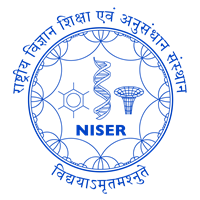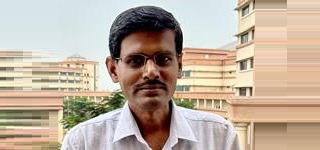

Professor
himansuniser.ac.in
+91-674-2494000 > 2186
BSc. (1997-2000) with Chemistry Hons. from Bhadrak College, Bhadrak, India.
MSc. (2000 - 2002) with Organic Chemistry Specialization from Utkal University, Vanivihar, Bhubaneswar, India
Ph.D. (2003-2009) with Prof. Sanjay Wategaonkar, Tata Institute of Fundamental Research (TIFR), Mumbai, India
Post Doctoral Associate: (2009 - 2011) with Prof. Michel Mons, Commissariat à l´Énergie Atomique (CEA), Saclay, France (CEA), Saclay, France
Post Doctoral Associate: (2011 - 2012) with Prof. Jennifer Ogilvie, University of Michigan (UoM), Michigan, USA
Professional Experience
2022 - Present: Professor at School of Chemical Sciences, NISER Bhubaneswar
2018 - 2022: Associate Professor at School of Chemical Sciences, NISER Bhubaneswar
2015 - 2018: Reader-F at School of Chemical Sciences, NISER Bhubaneswar
2014 - 2015: Assistant Professor at School of Chemical Sciences, NISER Bhubaneswar
2012 - 2014: DST INSPIRE Faculty at School of Chemical Sciences, NISER Bhubaneswar
Laser Spectroscopy, Chiroptical Spectroscopy, Instrumentation, and Computational Chemistry
A teacher always feels happy and proud of his/her students' achievements and accomplishments. No award is bigger than those feelings.
Member Editorial Advisory Board of The Journal of Physical Chemistry Letters
Membership in Professional Societies
Fellow of Royal Society of Chemistry (FRSC), UK
Chemical Research Society of India (CRSI)
Indian Society for Radiation and Photochemical Sciences (ISRAPS)
National Magnetic Resonance Society of India (NMRS-India)
Indian Photobiology Society (IPS)
Indian Society of Atomic and Molecular Physics (ISAMP)
Orissa Chemical Society (OCS)
Association of Chemistry Teachers (ACT)
Indian Science Congress Association (ISCA)
Reviewer for International Journals
Journal of the American Chemical Society, Advanced Materials, Chemical Communications, J. Phys. Chem. Lett., Chemistry- A European Journal, ChemPhysChem, J. Phys. Chem. A, Physical Chemistry Chemical Physics, RSC Advances, Organic & Biomolecular Chemistry, Chemical Physics, Chemical Physics Letter, Spectrochimica Acta, Journal of Molecular Liquids, Journal of Chemical Information and Modeling, Journal of Chemical Science, Current Science, ACS Omega, Journal of Computational Chemistry, Journal of Sulfur Chemistry, QRB Discovery, Analytical Chemistry, Journal of Molecular Structure, Journal of Photochemistry & Photobiology, Polyhedron, Scientific Reports, Environmental Science & Technology, Computational and Structural Biotechnology Journal, Chemistry Select
Recent and Selected List (Full List Link)
Reviews
Research Articles
Our research focuses on understanding the crucial role of noncovalent interactions (NCIs) in controlling the properties and behavior of chemical and biological systems. We investigate a wide range of NCIs, including:
Research Areas:
We investigate how these NCIs impact a wide range of phenomena, including:
Research Methods:
To unravel the intricacies of these interactions, we employ a multidisciplinary approach that combines:
Spectroscopy Techniques:
Computational Methods: Utilizing advanced simulations and modeling techniques, including electronic structure calculations and molecular dynamics simulations, to gain deeper insights into NCI-driven processes.
Education and Outreach:
We are committed to bridging the gap between rural students and cutting-edge research. To this end, we have developed "ViLEG" (Virtual Laboratory Experiments for Graduates). This innovative software provides virtual access to sophisticated instruments such as UV and IR spectrometers, fluorimeters, electrospray ionization mass spectrometers (ESI-MS), and NMR spectrometers etc., enabling students to gain valuable research experience and develop essential skills.
Please go through our home page to learn more about our research and publications.
We are looking for Post Doc. with external fellowship.
Akshay Kumar Sahu
Saiprakash Rout
Laxmipriya Dash
Madhusmita Parida
Anant Ram Satpathi
Ankita Sahoo
Radharaman Samanta
Sarang S.
Mitakshi
Prateeksha K.V
Avani K V
Vishnu Santosh Kumar
Dr. Apramita Chand
Dr. Minati Das
Dr. S. C. Makhal
Dr. Subhrakant Jena
Dr. V. R. Mundlapati
Dr. Dipak K. Sahoo
Dr. Subhrakant Jena
Dr. Juhi Dutta
Dr. Shubhranshu S, Choudhury
Dr. Kiran Devi Tulsiyan
Nitish Pal
Arun Gagrai
Prince Tiwari
Sanjeev Gauttam
Ankit Singh
Srikant Sethi
Suman Bhumik
Kalyani Bhagwani
Ashish Shihna
Abhijit Rana
Ambuj Dhakad
Abhijeet Singh Bhadauria
Chinmay Rouray
Shivam Mahapatra
Jyothish Kumar J
PCPN Hembram
Saswat Kumar Pati
Ashutosh Mahalik
Pranay Mohanty
Rudhi R. Sahoo
Sriman S. S. Mishra
Theory Courses :
Chemistry-I (C101)
Chemical Thermodynamics (C202)
Quantum Chemistry I (C206)
Mathematical Methods for Chemists (C207)
Chemical Binding (C305)
Chemical Rate Processes (C402)
Advanced Fluorescence Spectroscopy (C568)
Molecular Quantum Mechanics (C702)
Laboratory Courses :
Chemistry Lab I (C141)
Electronics Lab.(C242)
Physical Chemistry Lab I (C243)
Physical chemistry Lab. II (C343)
Physical chemistry Lab. for Int. Ph.D. (C744)
Virtual Laboratory Experiments for Graduates (ViLEG)
We designed a software called "ViLEG" (Virtual Laboratory Experiments for Graduates). The purpose of this software is to demonstrate to the rural students the experiments that use sophisticated instruments like fluorimeter, TCSPC, ESI-MS and NMR spectrometer. Most of the colleges in Odisha do not have access to these instruments. On weekends and holidays, we visit remotely located colleges to demonstrate the use of the software.
Member, Board of Studies, Chemical Sciences, HBNI